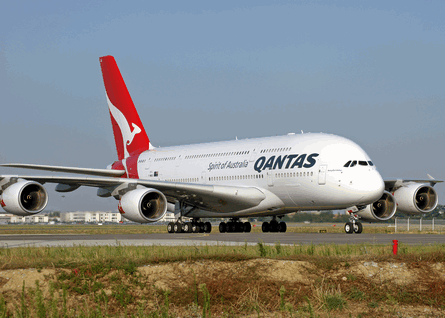A Qantas Airbus A380 will perform a test flight in the next six months as part of the Asia and Pacific Initiative to Reduce Emissions (ASPIRE) programme involving Airservices Australia, Airways New Zealand and the US Federal Aviation Administration.
The first of three ASPIRE test flights, designed to measure the impact of optimum flight conduct on reducing carbon emissions, was performed on 12 September by an Air New Zealand Boeing 777 flying between Auckland and San Francisco, with the flight using 4,542 litres (1,200USgal) less fuel and producing 11t less carbon monoxide than normal.
The fuel and emissions savings were slightly better than predicted, according to Airways NZ, with 5min also knocked off the normal flight time.
The initial test flight is set to be followed by a Qantas A380 flight between Australia and Los Angeles and a United Airlines Boeing 747-400 flight between the US West Coast and Sydney. The flights, conducted on normal scheduled revenue services, are intended to provide an understanding of the potential savings in fuel and emissions achievable, says Airways NZ.
 |
|---|
© Qantas |
The ASPIRE agreement was signed by the three air navigation service providers in February to accelerate the development and implementation of operational procedures to reduce the environmental footprint for all phases of flight.
The ANZ flight, ASPIRE 1, used air traffic management concepts and technologies to maximise efficiency in all phases. "The perfect flight" benefited from the removal of normal operational restraints, including air traffic congestion-control vectoring, air traffic fixed-route structure, procedures, flow restrictions and airline restraints, says Airways NZ.
Prior to pushback, instead of using the aircraft's auxiliary power unit, air conditioning and electrical power was supplied from the airport aerobridge. In addition, a "just in time" fuelling concept was used whereby the tanker loads 2,000kg (4,400lb) less fuel than the initial estimate until the final fuel requirements are verified 20min prior to departure.
Engine start was managed to minimise aircraft holding, while taxi speed was managed to avoid slowing down or speeding up at the take-off clearance point.
The aircraft received a priority departure route and unimpeded climb through to cruise altitude.
En route the flight followed user preferred routes (UPR), while dynamic airborne reroute procedure allowed it to alter the UPR based on updated wind and weather information. The flight also benefited from 30nm separation standards which Airways NZ has implemented across the Pacific.
The descent into San Francisco involved a tailored arrival or continuous descent arrival, which uses less fuel and causes less emissions and noise than a normal approach. The aircraft received priority taxi clearance directly to the gate, where it received electrical power and air conditioning from the aerobridge.
AirSpace images: Qantas A380 gallery
Source: Flight International



















